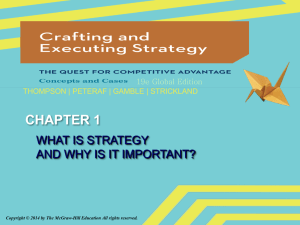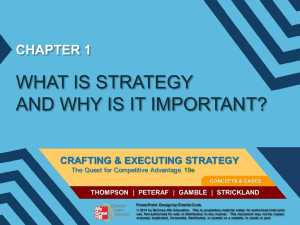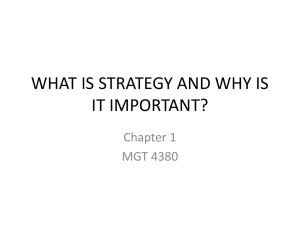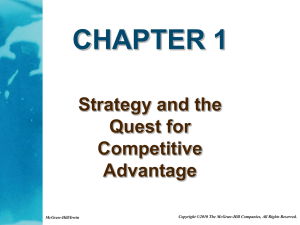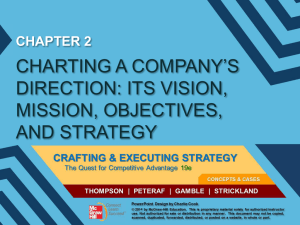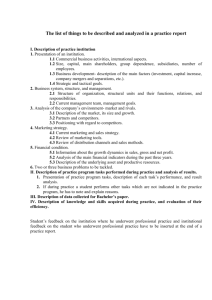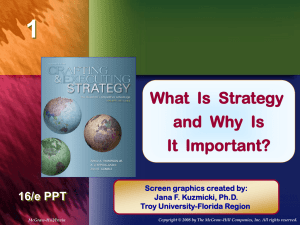Chapter 1
advertisement
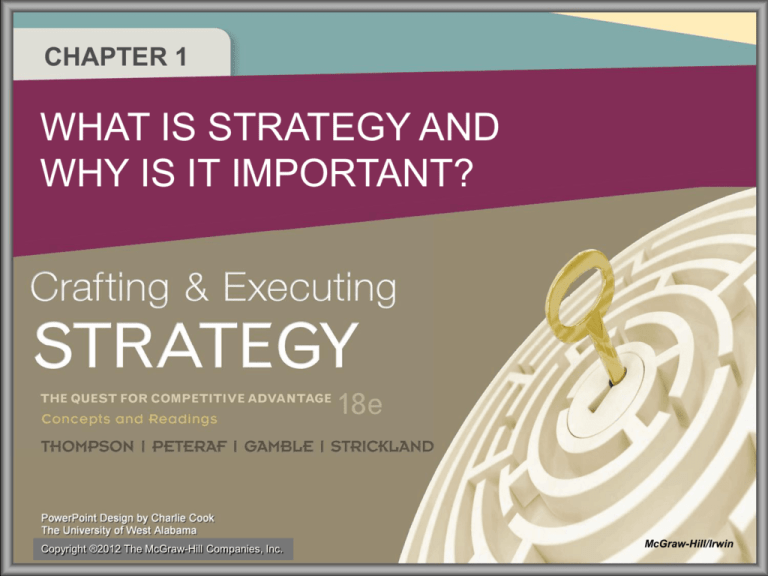
CHAPTER 1 WHAT IS STRATEGY AND WHY IS IT IMPORTANT? Copyright ®2012 The McGraw-Hill Companies, Inc. McGraw-Hill/Irwin 1. Understand why every company needs a sound strategy to compete successfully, manage the conduct of its business, and strengthen its prospects for long-term success. 2. Develop an awareness of the four most dependable strategic approaches for setting a company apart from rivals and winning a sustainable competitive advantage. 3. Understand that a company’s strategy tends to evolve over time because of changing circumstances and ongoing management efforts to improve the company’s strategy. 4. Learn why it is important for a company to have a viable business model that outlines the company’s customer value proposition and its profit formula. 5. Learn the three tests of a winning strategy. 1–2 WHAT DO WE MEAN BY STRATEGY ? ♦ What is our present situation? ● Business environment and industry conditions ● Firm’s financial and competitive capabilities ♦ Where do we want to go from here? ● Creating a vision for the firm’s future direction ♦ How are we going to get there? ● Crafting an action plan that will get us there 1–3 WHAT IS STRATEGY ABOUT? ♦ Strategy is all about How: ● How to outcompete rivals. ● How to respond to economic and market conditions and growth opportunities. ● How to manage functional pieces of the business. ● How to improve the firm’s financial and market performance. 1–4 WHY DO STRATEGY ? ♦ A firm does strategy: ● To improve its financial performance. ● To strengthen its competitive position. ● To gain a sustainable competitive. advantage over its market rivals. ♦ A creative, distinctive strategy: ● Can yield above-average profits. ● Makes competition difficult for rivals. 1–5 STRATEGY AND COMPETITORS ♦ Strategy is about competing differently from rivals— ● Doing what they don’t do or doing it better! ● Doing what they can’t do! ● Doing that which sets the firm apart and attracts customers. ● Doing what we should or should not do to produce a competitive edge. 1–6 1.1 Identifying a Company’s Strategy—What to Look For 1–7 Key initiatives of the Plan-to-Win strategy: • Improved restaurant operations • Affordable pricing • Wide menu variety and beverage choices • Convenience and expansion of dining opportunities • Ongoing restaurant reinvestment and international expansion 1–8 Follow-up • Which of McDonald’s Plan-to-Win strategy initiatives are associated with meeting customer needs more effectively? • Which initiatives are focused on more efficiently delivering products and services? • Which initiatives will likely result in the most enduring competitive advantage? • Which of the initiatives will competitors likely attempt to overcome first? 1–9 The Quest for Competitive Advantage ♦ Competitive Advantage ● Meeting customer needs more effectively, with products or services that customers value more highly, or more efficiently, at lower cost. ♦ Sustainable Competitive Advantage ● Giving buyers lasting reasons to prefer a firm’s products or services over those of its competitors. 1–10 STRATEGIC APPROACH CHOICES Building Competitive Advantage Low-cost provider Differentiation on features Focus on market niche Best-cost provider 1–11 STRATEGIC APPROACHES ♦ Building a competitive advantage by: 1. Striving to become the industry’s low-cost provider (efficiency). 2. Outcompeting rivals on differentiating features (effectiveness). 3. Focusing on better serving a niche market’s needs (efficiency and\or effectiveness). 4. Offering the lowest (best) prices for differentiated goods (best-cost provider). 1–12 GAINING SUSTAINABLE COMPETITIVE ADVANTAGE ♦ How to create a sustainable competitive advantage: ● Develop valuable expertise and competitive capabilities over the long-term that rivals cannot readily copy, match or best. ● Put the constant quest for sustainable competitive advantage at center stage in crafting your strategy. 1–13 Why a Firm’s Strategy Evolves over Time ♦ Managers modify strategy in response to: ● ● ● ● ● ● Changing market conditions Advancing technology Fresh moves of competitors Shifting buyer needs Emerging market opportunities New ideas for improving the strategy 1–14 The Evolving Nature of a Firm’s Strategy ♦ Realized (current) strategy is a blend of: ● Proactive (deliberate) strategy elements that include both continued and new initiatives. ● Reactive (emergent) strategy elements that are required due to unanticipated competitive developments and fresh market conditions. 1–15 1.2 A Company’s Strategy Is a Blend of Proactive Initiatives and Reactive Adjustments 1–16 THE RELATIONSHIP BETWEEN A FIRM’S STRATEGY AND ITS BUSINESS MODEL Realized Strategy $$$? Business Model Competitive Initiatives Value Proposition Business Approaches Profit Formula 1–17 A Company’s Business Model ♦ How the business will make money : ● By providing customers with value. The firm’s customer value proposition ● By generating revenues sufficient to cover costs and produce attractive profits. The firm’s profit formula It takes a proven business model—one that yields appealing profitability—to demonstrate viability of a firm’s strategy. 1–18 Business Model Elements ♦ The Customer Value Proposition ● Satisfying buyer wants and needs at a price customers will consider a good value. The greater the value provided (V) and the lower the price (P), the more attractive the value proposition is to customers. 1–19 Business Model Elements (cont’d) ♦ The Profit Formula ● Creating a cost structure that allows for acceptable profits, given that pricing is tied to the customer value proposition. V—the value provided to customers P—the price charged to customers C—the firm’s costs The lower the costs (C) for a given customer value proposition (V–P), the greater the ability of the business model to be a moneymaker. ● 1–20 IS OUR STRATEGY A WINNER? The Strategic Fit Test The Competitive Advantage Test Winning Strategy The Performance Test 1–21 WHAT MAKES A STRATEGY A WINNER? ♦ A winning strategy must pass three tests: ● The Fit Test Does it exhibit dynamic fit with the external and internal aspects of the firm’s overall situation? ● The Competitive Advantage Test Can it help the firm achieve a significant and sustainable competitive advantage? ● The Performance Test Can it produce good performance as measured by the firm’s profitability, financial and competitive strengths, and market standing? 1–22 1–23 Follow-up Who listens to the radio anymore? • Given the shifts in how people listen to music, are the business models of Sirius XM and over-the-air broadcasters viable over the long term? • Does Sirus XM’s strategy pass the three tests of a winning strategy? Does the strategy of over-the-air broadcasters pass the same tests? • What internal and external factors will create difficulties for either competitor in changing its strategy or business model? 1–24 WHY CRAFTING AND EXECUTING STRATEGY ARE IMPORTANT TASKS ♦ Strategy provides: ● A prescription for doing business. ● A road map to competitive advantage. ● A game plan for pleasing customers. ● A formula for attaining long-term standout marketplace performance. Good Strategy + Good Strategy Execution = Good Management 1–25 THINKING STRATEGICALLY ♦ Google’s web browser-based Chrome operating system and its online applications suite are now challenging Microsoft’s long-term dominance of those marketplace sectors. ● What should be Microsoft’s first response to this competitive challenge? ● How will Microsoft’s response to this competitor’s actions affect its business model? ● Which competitor’s strategy will likely be the eventual winner in the marketplace? 1–26 THE ROAD AHEAD ♦ Strategy is about asking the right questions: ● What must managers do, and do well, to make a firm a winner in the marketplace? ♦ Strategy requires getting the right answers: ● Good strategic thinking and good management of the strategy-making, strategy-executing process. ● First-rate capabilities and skills in crafting and executing strategy are essential to managing successfully. Welcome and best wishes for your success! 1–27
